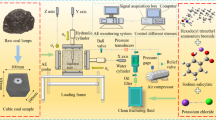Abstract
Air gap in an explosive column has long been applied in open-pit blasting as a way of reducing explosive charge, vibration, fly rock and improve fragment size. In conventional blasting a greater amount of explosive energy is lost in the generation of oversize fragments. Oversize fragments reduces loading and hauling efficiencies of equipment which requires secondary blasting. Recurring oscillation of shock waves in the air gap increases the time over which it acts on the adjacent rock mass by factor of 2–5. Top air deck blasting technique trial conducted with an application of gas bags at Chimiwungo pit resulted in an improved fragmentation of about 94 % less than 950 mm. Results obtained from the analysis of muckpile images using split-desktop exhibited that the mean fragment size was 264.81 mm and F20, F80 and top-size were 41.99, 683.18 and 1454.69 mm respectively. Optimum crusher feed size was as large as 1200 mm and crushed down to the 40 mm and only a small percent of the material was above 1200 mm. Gas bag application resulted in a significant reduction in explosives load in production holes without loss in fragmentation or movement of the collar zone. This reduced total cost of charging as compared to conventional blasts with a variance of $20, powder factor was dropped to an average of 0.86 kg/bcm. The technique reduced the cost of bulk blend explosive by 15 %, reduced overall cost of charging per hole by 12 %, enhanced premature ejections. The overall blast results were satisfactory, 443,624 tonnes of blasted material from the block which represented 90 % of the total muckpile material was within 900 mm size. The overall muckpile blasted was well fragmented.








Similar content being viewed by others
References
Chiappetta F (2004) New blasting technique to eliminate subgrade drilling, improve fragmentation, reduce explosive consumption and lower ground vibrations. J Explos Eng 21(1):10–12
Chiappetta RF, Mammele ME (1987) Analytical high-speed photography to evaluate air decks, stemming retention and gas confinement in presplitting, reclamation and gross motion applications. In: Proceedings of the 2nd international symposium on rock fragmentation by blasting, Society for Experimental Mechanics, Bethel, pp 257–301
Cunningham CVB (1983) The Kuz-Ram model for prediction of fragmentation from blasting. In: Proceedings of 1st international symposium on rock fragmentation by blasting, Lulea, pp 439–453
Fourney WL, Barker DB, Holloway DC (1981) Model studies of explosives well stimulation techniques. Int J Rock Mech Min Sci 18:113–127
Hustrulid W (1999) Blasting principles for open pit mining, vol 1. A.A. Balkema Publishers, Rotterdam
Jhanwar J (2011) Theory and practice of air—deck blasting in mines and surface excavations—a review. Geotech Geol Eng 29(5):651–663
Jhanwar JC (2012) Investigation into the influence of air-decking on blast performance in opencast mines in India: a study. Blast Min New Trends. doi:10.1201/b13739-14
Jhanwer JC, Jethwa JL (2000) The use of air deck in production blasting in an open pit coal mine. Geotech Geol Eng 18:269–287
Jhanwar JC, Jethwa JL, Reddy AH (2000) Influence of air deck blasting on fragmentation in jointed rocks in an open pit manganese mine. Eng Geol 57:13–29
Kulatilake PHSW, Hudaverdi T, Wu Q (2012) New prediction models for mean particle size in rock blast fragmentation. Geotech Geol Eng 30(3):665–684
Kuznetsov VM (1973) The mean diameter of the fragments formed by blasting rock. J Min Sci 9(2):144–148
Liu L, Katsabanis PD (1996) Numerical modelling of the effects of air decking/decoupling in production and controlled blasting. In: Proceeding 5th international conference on rock fragmentation by blasting. AA Balkema, Rotterdam, pp 319–330
Melnikov NV, Marchenko LN (1970) Effective methods of application of explosion energy in mining and construction. In: The 12th US symposium on rock mechanics (USRMS). American Rock Mechanics Association
Moxon NT, Mead D, Richardson SB (1993) Air-decked blasting techniques: some collaborative experiments. Trans Inst Min Metall (Section A: Mining Industry) 102:A25–A30
Richards M, Nisbet B (2003) The geology of the Mwombezhi dome and Malundwe and Chimiwungo copper deposits Northwest Province Zambia Equinox, Kitwe
Rosin P, Rammler E (1933) Regularities in the distribution of cement particles. J Inst Fuel 7:29–33
Sharma PD (2015) Application of air-deck technique in surface blasting. http://miningandblasting.wordpress.com/, http://miningandblasting.wordpress.com/. Retrieved 4 Oct 2015
Siddiqui FI, Shah SA, Behan MY (2009) Measurement of size distribution of blasted rock using digital image processing. J King Abdulaziz Univ 20(2):81–93
Stroud R (2010) 2010 life of mine plan Malundwe/Kanga and Chimiwungo pits. Optiro Pty Limited, Perth
Author information
Authors and Affiliations
Corresponding author
Rights and permissions
About this article
Cite this article
Kabwe, E. Improving Collar Zone Fragmentation by Top Air-Deck Blasting Technique. Geotech Geol Eng 35, 157–167 (2017). https://doi.org/10.1007/s10706-016-0094-7
Received:
Accepted:
Published:
Issue Date:
DOI: https://doi.org/10.1007/s10706-016-0094-7




